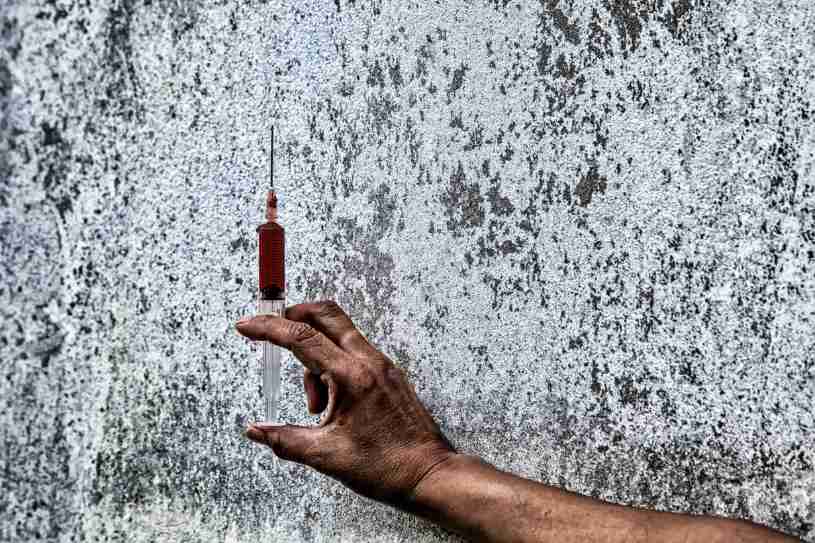
The Russian drug Krokodil, also known in pharmaceutical terms as Desomorphine, belongs to the class of opioid drugs. Being a derivative of codeine, this substance is a semi-synthetic opioid and is up to eight times more potent than Morphine. In 2012, it was reported that this substance is associated with between 5000-7000 deaths in Russia and injuries in the United States. With these statistics, it is essential to learn the dangers this medication gives to one’s health.
Table Of Contents:
In this article, more information about the drug Krok, its short-term and long-term side effects, Krokodil addiction, abuse, and overdose, how long the drug stays in the system, Krok withdrawal, detox, and how to treat addiction from this drug will be provided.
What Is Krokodil?
Also known as “Krok” or “Croc”, this substance is considered as a heroin substitute that can be made at home. According to the National Criminal Justice Reference Service, Krok is also referred to as “poor man’s heroin” as it is perceived to be a cheaper alternative injectable mixture to the heroin substance. Furthermore, according to a study of doctors from Poland, with its active ingredient Desomorphine, Krok is considered as the new designer drug of abuse in the East and is considered by the FDA as an illicit medication. Additionally, there have been no accepted legit uses for Desomorphine or Krok in the United States since 1963.
Desomorphine History
Desomorphine was first synthesized in Switzerland, in 1922, without being recognized by the medical community. However, in the following decades, medical professionals started to appreciate the substance, and not long after it entered commercial use under the name Permonid. Russian physicians also prescribed Desomorphine to treat severe pain, but by the end of the 20th century, it was practically a forgotten medicine. Only in 2010, after the outbreak of the Desomorphine addiction epidemic in Russia, this drug started to gain attention for its detrimental side-effects and innumerable casualties. Quickly, Desomorphine became known as the Russian drug Krokodil, and it spread throughout the whole ex-Soviet Union.
Due to a relatively fast and simple synthesis process, this substance has found its way to most drug markets all around the world, albeit with a much weaker impact. A case of Krokodil abuse in the USA has been recorded and analyzed, although the experts agreed that this was an isolated case.
Krokodil Ingredients And Mechanism Of Action
Besides Desomorphine, many other Krokodil drug ingredients contribute to the severity and consequences of addiction. For instance, clandestine Desomorphine synthesis involves numerous dangerous components such as Codeine pills, red phosphorus, iodine, lighter fluid, hydrochloric acid, ethanol, and paint thinner. The result is a mixture of various substances called Krok.
A study of doctors in Armenia asserts that there are many other ingredients present in Desomorphine mixtures, as addicts can easily make their batch of this substance, which means that the drug Krok recipe varies. These additional ingredients, along with the ones above such as phosphorus and paint thinner, only contribute to the detrimental effects of pure Desomorphine, which is dangerous on its own.
Thanks to its mechanism of action, agonist effect on the brain’s opioid receptors, Desomorphine acts as an analgesic and sedative, producing euphoria and relieving pain. Krokodil drug is also a muscle relaxant, and this can sometimes lead to serious health complications. The additional ingredients, like red phosphorus, act peripherally, destroying the surrounding tissues. Lead from gasoline inhibits zinc-related enzymes, which in turn causes neurological problems, by affecting hippocampal tissue.
Krok is an illicit, extremely hazardous substance. Never attempt to recreate any recipe of this drug in your home for any personal health treatment as it may lead to terrible health consequences as well as legal issues. The manufacturing of this drug and other illicit substances is punishable by law.

What Are Krokodil Effects?
Krokodil effects, on their own, are intense and potentially life-threatening. This substance is a powerful opioid with strong sedative effects. Other ingredients that can be found alongside Desomorphine, only increase the dangers of the Krokodil drug. People abusing this substance experience a fast onset of euphoria as the drug is injected into the person’s bloodstream. In the next few hours, the sedative and stupefying effects of the Krokodil drug take hold. Desomorphine addicts experience both short-term and long-term side effects when abusing this dangerous substance.
Short-Term Effects of Krokodil
According to news reports, short-term Krokodil effects resemble that of other opioids, although Desomorphine is more potent than most of them. As a result, people addicted to this substance experience negative consequences quite fast; shortly after the drug is injected.
Some of the Most Dangerous Short-term Krokodil Effects Include:
- Powerful sedation
- Pain at the injection site
- Localized skin lesions and abscesses surrounding the puncture
- Lack of coordination (inability to walk properly)
- Slow and shallow breathing
The first news report associated with Krok came from Russia in the year 2004. In this report, it was stated that this substance causes short-term seizures. In case one has experienced this short-term side effect, it is highly advised to seek medical help to avoid other health dangers.
Long-Term Effects of Krokodil
The exact nature and quality of long-term effects of Krokodil depend on the ingredients found alongside Desomorphine. According to a clinical review published in Forensic Science International, when addicts continuously abuse such substances as red phosphorus, paint thinner, and lighter fluid, serious chronic effects of Krokodil tend to occur. Aside from this being linked with Desomorphine addiction, the whole organism suffers under the weight of this ghastly substance. According to a study published in Toxicology Letters, organ damage is the most common side effect of Krokodil abuse. Other long-term effects of Krokodil will be discussed in the information below.
Krok and the Dermal & Circulatory Systems
The body system affected by the Krokodil abuse the most is the integumentary system or the skin, and according to some news, this substance is also known as “The Russian flesh-eating drug”. Aside from simple Krok wounds, according to a study of medical doctors from Portugal and Brazil, repeated intravenous administration of this substance causes extensive skin necrosis. Also known as gangrene, this condition is irreversible, meaning the body tissue of the person permanently dies and it is characterized by crocodile-like, black, scaly skin. In another study of physicians from Canada, gangrene is also caused by blood vessel damage because the body tissues do not get the right blood supply. When a patient has skin necrosis, there is a potential growth of the bacteria Proteus vulgaris and Morganella morganii. The medications prednisone can be used as a temporary wound care treatment but again, this skin condition is still irreversible.
Krok and the Respiratory System
In compliance with a study published in the Current Pharmaceutical Analysis, one of the long-term Krokodil effects is respiratory failure. It was reported that this side effect is common and extremely dangerous to the health as it causes fatalities. In the same study, in 2017, one person from Colorado died from respiratory depression associated with the use of Krok. In another study published in the Journal of Student Research, respiratory depression is 10x than that of Morphine. Lastly, according to a study of medical doctors from the Netherlands, Krok is also associated with pneumonia.
Krokodil Effects on the Oral Health / Skeletal System
Bone damage can also be seen from Krokodil abuse as it can cause osteonecrosis (bone tissue death) and osteomyelitis (bone tissue infection). This occurs when one injected the substance and the substance causes rotting from the skin to the bone. It was reported that bone damages are serious and mutilating. Krok also influences the dental and oral health of its users. Krokodil abuse can cause mucosal changes, a high risk of caries, and periodontitis (severe gum infection). Additionally, according to a study published in The American Journal of Medicine, severe bone damage from Krok use can lead to amputation.
Krok and the Central and Peripheral Nervous System
Krok abuse causes neurological damages such as memory loss and encephalopathy. Physical and psychological dependence are also possible from Krok use. Since the effects of Krokodil are quite drastic, which contributed to the drug’s notoriety and increased people’s awareness about the dangers of addiction. Unfortunately, some people continue to use street Desomorphine as a cheap heroin substitute. In comparison with heroin, Krok produces much more damage to the body due to its impurity.

Krokodil Addiction And Abuse Overview
According to the United Nations Office on Drugs and Crime, along with the United States, the countries affected by Krokodil addiction and abuse include Armenia, Georgia, Italy, Poland, Russia, Spain, and the United Kingdom. From these countries since 2014, Russia has the most number of Krok users with reported deaths and injuries (217), followed by Georgia (160), and Armenia (47). In this section, information about the symptoms of physical and psychological Krokodil addiction and who is most at risk of this addiction will be provided.
Psychological Krokodil Abuse and Addiction Signs
According to a study in Spain, Krok is included by the European Monitoring Centre for Drugs and Drug Addiction (EMCCDA) in overviews prepared for the Republics of Georgia and Kazakhstan since it causes addiction and dependence in a very short time. Some of the most important symptoms of psychological Krokodil addiction include:
- Craving
- Inability to think properly, lack of focus
- Restlessness, anxiety, jitteriness
- Depression and lack of motivation (due to abstinence)
Abusers of Krokodil drugs and other illicit substances are also likely to isolate themselves from friends and families. In case one is seen with these behaviors, it is advised to seek medical resources such as rehabilitation to avoid other mental health dangers.
Physical Krokodil Abuse and Addiction Signs
According to a study in Greece, chronic consumption or frequent administration of Krokodil drugs will lead to the development of physical addiction, characterized by tolerance and abstinence syndrome. Tolerance simply means that a Krok addict needs to take more and more Desomorphine to get the same effects. Abstinence syndrome happens when an addict stops using Desomorphine, and symptoms may vary from flu-like health complications, high body temperature, shivering, sweating, to delirium, and psychological breakdown. Abstinence syndrome is further complicated by constant skin infections and other symptoms experienced by Krok addicts.
Furthermore, the Most Conspicuous Physical Signs of Krok Use Include:
- Very small pupils
- Lack of muscle tonus, the person who uses Desomorphine, may appear overly relaxed and slouched
- Prolonged reaction time
- Nodding out
- Slurred speech
Aside from these Krok symptoms, as said, severe skin ulceration and damage will be the easiest to notice. If any of these signs and symptoms are observed, it is advised to seek immediate medical care.
Who Is Most At Risk Of Krokodil Abuse and Addiction?
According to the US Drug Enforcement Administration, the Krok user population has been increasing since 2009, as lots of young adults, especially in Russia, search for cheaper heroin alternatives. In another study published in Substance Use and Misuse, economically poor regions are most at risk of Krokodil addiction. Since Krok is synthesized, those who can freely access the ingredients in making Krok are at risk of this addiction.
Krokodil Overdose
The US Drug Enforcement Administration claims the Russian drug Krokodil has greater toxicity compared to Morphine. Thus, overdose on this medication is highly possible and it has two basic components: Desomorphine overdose and acute toxic effect of additional ingredients (like, for instance, red phosphorus).
Some of the Krok Overdose Signs Include:
- Allergic reactions
- Seizures
- Respiratory depression
- Extreme nausea and vomiting
- Inability to move or walk
According to a study published in the Journal of Medicinal Chemistry, the reason why Krok is highly an overdosing drug is because of its high fat solubility. Individuals who overdose are often unconscious or completely unresponsive to external stimuli and if these symptoms are not appropriately treated, death will ensue in most cases. Anyone who experiences unfamiliar symptoms while using Desomorphine or other opioids should contact a medical provider immediately.
What To Do If Someone Has Overdosed On Krokodil?
First of all, people who find a person overdosing on Krokodil drugs should call 911 immediately. There are a few things that can be done before the ambulance arrives, and these are:
- Clear airways- check the person’s nose and mouth. Sometimes, overdosing addicts swallow their tongues, which then leads to choking.
- Move the person to their side in case of vomiting.
- Try to wake the person up gently.
- Stay around and wait for the ambulance to arrive.
- Use Narcan.
Narcan is a potent opioid receptor antagonist (i.e., it reverses the effect of Desomorphine), and it is the first line of defense against overdoses. It is equally important to know what not to do when someone overdoses:
- Do not wait until it wears off.
- Do not give any substance to the person who’s overdosing, except Narcan.
- Do not leave the individual alone.
As stated in the previous sections, fatality or death is possible with Krok use. A person by the side of a patient who overdosed on Krok must keep his or her presence of mind and stay focused while waiting for medical help.
Krokodil Withdrawal And Detox
Sudden cessation of use will lead to Krok withdrawal. It is important to note that, due to its relatively fast mechanism of action, Desomorphine quickly produces withdrawal symptoms. They sometimes appear as fast as only six hours after the last Desomorphine injection. This is another reason why this drug is hazardous and addictive. Withdrawal symptoms can begin as soon as 6 hours after the last dose and will reach their peak 1-2 days. Eventually, it will ultimately wane after about six days.
Addicts Who Go Through the Withdrawal Phase Experience These Symptoms:
- Anxiety and agitation
- Abdominal cramping
- Goosebumps
- Muscle aches
- Insomnia
- Nausea and vomiting
- Emotional disturbance
- Confusion
It was also reported that the withdrawal symptoms of Krok are mostly the same as Morphine but they form more rapidly. However, this does not mean that it is better to go for Morphine. The abuse of both substances is prohibited and dangerous.
How Long Does Krokodil Stay In The System?
Desomorphine quickly starts showing its effects and wanes quickly. The half-life of Desomorphine is similar to Morphine and that is about 2-3 hours. As said, its effects disappear quickly, which is why addicts tend to re-dose and aggravate the negative consequences of Desomorphine use. It was reported that the substance stays in the blood and urine for a short period, a few hours in the blood, and around 3 days in the urine. However, according to The American Journal of Medicine, although routine drug screenings can test opiates, they cannot identify Desomorphine.
Treating Krokodil Addiction
Treatment of substance addiction encompasses both psychological (mental) and physical healthcare. Due to severe physical damage caused by Krokodil addiction, most addicts should seek help and first be treated in controlled hospital conditions. For instance, treating various life-threatening infections and health complications like gangrene or sepsis are by far the primary goals of treating Desomorphine addiction. After solving these primary physical health problems, an individual can be treated in a rehabilitation facility for addicted ones, where more emphasis is put on the psychological causes of substance abuse problems.
Hope Without Commitment
Find the best treatment options. Call our free and confidential helpline
Most private insurances accepted
Find Drug Rehabilitation Centers Near You Anywhere In the US
Addiction Resource team has compiled an extensive list of the top drug rehabilitation facilities around the country. Use our locator tool to find the best centers near you.
Page Sources
- Alves, E. A., Brandão, P., Neves, J. F., Cravo, S. M., Soares, J. X., Grund, J. P. C., ... & Dinis Oliveira, R. J. (2017). Repeated subcutaneous administrations of krokodil causes skin necrosis and internal organs toxicity in Wistar rats: putative human implications. Human Psychopharmacology: Clinical and Experimental, 32(3), e2572.
- Alves, E. A., Grund, J. P. C., Afonso, C. M., Netto, A. D. P., Carvalho, F., & Dinis-Oliveira, R. J. (2015). The harmful chemistry behind krokodil (desomorphine) synthesis and mechanisms of toxicity. Forensic science international, 249, 207-213.
- Eddy, N. B., & Howes, H. A. (1935). Studies of morphine, codeine and their derivatives X. Desoxymorphine-C, desoxycodeine-C and their hydrogenated derivatives. Journal of Pharmacology and Experimental Therapeutics, 55(3), 257-267.
- Escribano, A. B., Negre, M. T. B., Orenga, G. C., Monfort, S. C., Peiró, F. A., Zapatero, S. M., & Cortés, G. H. (2016). Orally ingestion of krokodil in Spain: report of a case Consumo de krokodil por vía oral en España: a propósito de un caso. Adicciones, 28(4), 242-245.
- Florez, D. H. ., dos Santos Moreira, A. M., da Silva, P. R., Brandão, R., Borges, M. M. C., de Santana, F. J. M., & Borges, K. B. (2017). Desomorphine (Krokodil): An overview of its chemistry, pharmacology, metabolism, toxicology and analysis. Drug and alcohol dependence, 173, 59-68.
- Gahr, M., Freudenmann, R. W., Hiemke, C., Gunst, I. M., Connemann, B. J., & Schönfeldt-Lecuona, C. (2012). “Krokodil”—Revival of an old drug with new problems. Substance use & misuse, 47(7), 861-863.
- Ghazawi, F. M., & Beecker, J. (2019). Necrotic leg ulcers associated with krokodil injection in a 41-year-old man. Cmaj, 191(25), E712-E712.
- Grund, J. P. C., Latypov, A., & Harris, M. (2013). Breaking worse: the emergence of krokodil and excessive injuries among people who inject drugs in Eurasia. International Journal of Drug Policy, 24(4), 265-274.
- Hakobyan, K., & Poghosyan, Y. (2021). The efficacy of mylohyoid muscle flap use in surgical treatment of ‘krokodil’drug-related osteonecrosis of the mandible. Journal of Cranio-Maxillofacial Surgery.
- Haskin, A., Kim, N., & Aguh, C. (2016). A new drug with a nasty bite: A case of krokodil-induced skin necrosis in an intravenous drug user. JAAD case reports, 2(2), 174-176.
- Karakaya, İ. (2019). A New Danger in Our Midst: Krokodil (Desomorphine) Addiction.
- Katselou, M., Papoutsis, I., Nikolaou, P., Spiliopoulou, C., & Athanaselis, S. (2014). A “Krokodil” emerges from the murky waters of addiction. Abuse trends of an old drug. Life sciences, 102(2), 81-87.
- van Kempen, E. E., & Brand, H. S. (2019). Effects of krokodil (desomorphine) use on oral health-a systematic review. British dental journal, 227(9), 806-812.
- Sargent, L. J., & May, E. L. (1970). Agonists-antagonists derived from desomorphine and metopon. Journal of medicinal chemistry, 13(6), 1061-1063.
- Thekkemuriyi, D. V., John, S. G., & Pillai, U. (2014). ‘Krokodil’—a designer drug from across the Atlantic, with serious consequences. The American journal of medicine, 127(3), e1-e2.
- Zheluk, A., Quinn, C., & Meylakhs, P. (2014). Internet search and krokodil in the Russian Federation: an infoveillance study. Journal of medical Internet research, 16(9), e3203.


 Reviewed by:
Reviewed by:  Written by:
Written by: 

 FindTreatment.gov
FindTreatment.gov